
Tuesday February 24, 2004
QUICK CAT!
The SCX Jaguar Racing F-1
By Nils Frederiksen
Formula One may not have the zealous fan base in the US that it does in many other parts of the world, and SCX/Techni-Toys cars are equally overlooked by many American slot racers. That being said, the latest F-1 release by the Spanish company is both a sharp looker and a strong runner.
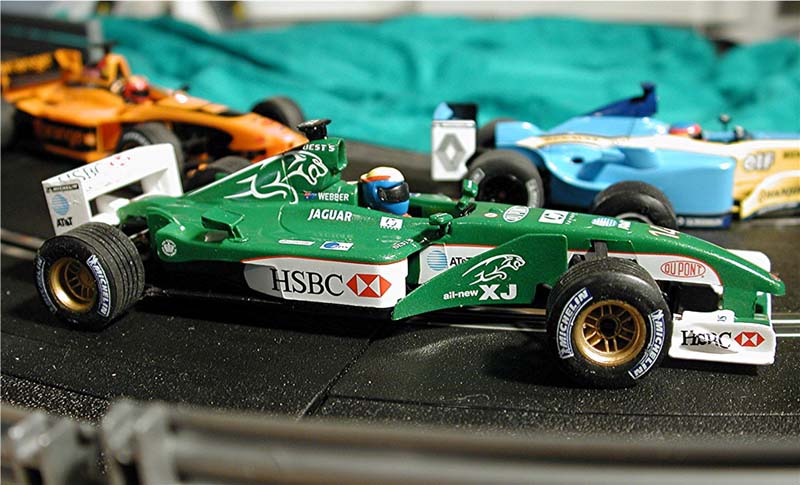
Jaguar has a long history of car-building and racing success, but their current Formula One program is relatively young, dating back to the 2000 season when Jaguar took over what had been the Stewart F-1 team. Jaguar finished 7th in the Constructors Championship for the 2003 season, behind the powerhouses of Ferrari, BMW/Williams, McLaren/Mercedes and Renault, but ahead of another relative newcomer – Toyota.
Australian Mark Webber – whose #14 car is the subject for this review – gave the Jaguar team its best finishes in 2003, crossing the line in 6th place in Hungary, France and the Grand Prix of Europe, and threatening the front-runners on numerous occasions. Webber finished in a tie for 9th in the 2003 Drivers Championship standings, with 17 points, and will continue his drive with Jaguar when the new 2004 season gets underway with the Australian Grand Prix on March 7.
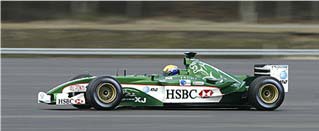
The SCX model is a very nice likeness for the 2003 Jaguar R-4. Two versions of the car were released: The #14 car of Mark Webber and the #17 car of Pedro De La Rosa. Unfortunately for SCX, De La Rosa left the Jaguar team before the start of the 2003 season to work as a test driver for the McLaren/Mercedes F-1 team, resulting in a model of a car that never ran. But, De La Rosa is Spanish, as is SCX, so it is understandable that the company would be very interested in producing the model. The De La Rosa car looks very much like the one Pedro drove for Jaguar in 2002, while the Webber car seems to be an accurate model of the car he drove in 2003.
Decorated in a very shiny medium metallic green, bright white and red accents and gold colored wheels, the car instantly jumps out of any pack of cars – which I am sure is exactly what the folks and Jaguar racing were thinking when designed the graphics for the real car. The outline of Jaguar’s famous “leaping cat” graces the sides of the engine cover, just behind the driver, along with the barge boards just behind the front wheels, and numerous other sponsors are scattered around the rest of the car. The exact locations of some sponsor markings can change from race to race, but compared to photos of the real Jaguar R-4 I would say that SCX got all the major ones correct.
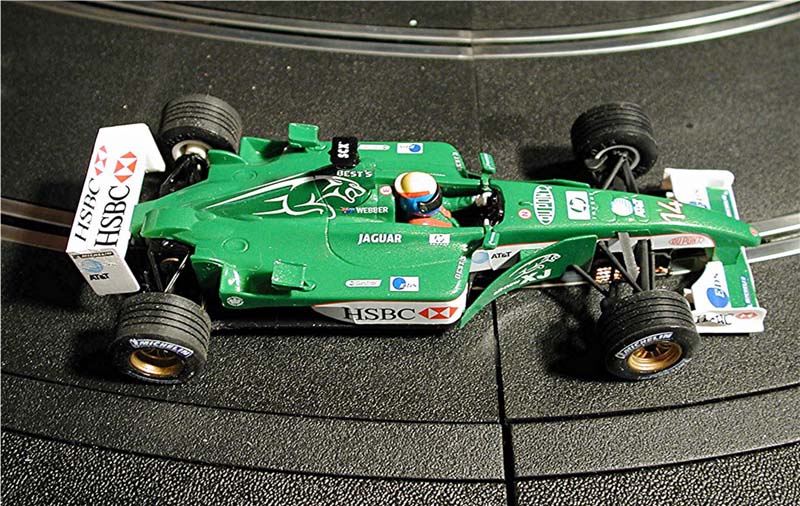
All the Tampo markings were crisp and clean on my car. The white was especially vivid, allowing no green to show through. The red pin-striping that separates the green and white along the sides of the car is equally sharp, with no blurriness or color bleed-through anywhere. Anyone with older SCX cars on their shelf will quickly be able to tell you how far the company has come in the past few years.
The only complaint I could come up with concerning the visual appearance of the car is the pronounced rearward tilt of the rear wing. It seems to relate to the way the wing unit attaches to the body. The tilt appears in numerous pictures of the SCX car taken by dealers around the world, so I assume it is typical of the model. I haven’t figured out a way to correct it yet, but I’ll let you know if I come up with something.
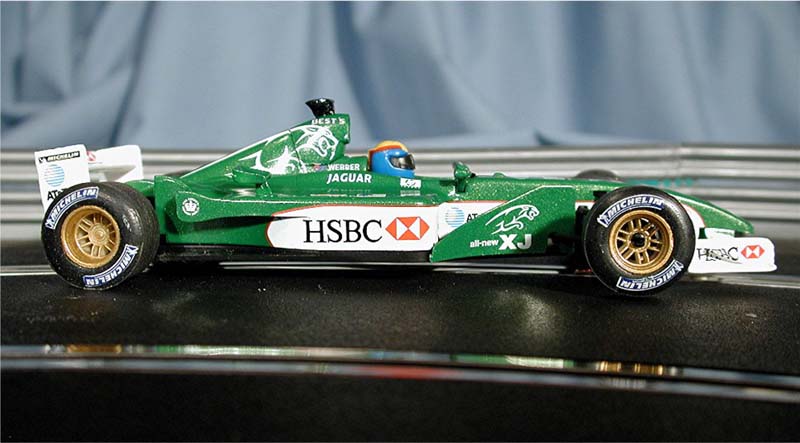
The car is powered by the standard SCX “F-1” motor, which is rated by the company at 16,500rpm. The motor spins a 9-tooth pinion, driving a 27-tooth crown gear. Up front the car draws power from a spring-loaded guide that includes a double row of braids. The front guide also connects to SCX’s steering front suspension. Not everyone likes the steering front set-up, and the various plastic links could be vulnerable to crash damage, but the guide and suspension combo worked fine on my Jag – as they do on several other SCX and Ninco Formula One cars I own. I can’t notice any performance difference between cars that steer and cars with solid front axles, but it does look cool to watch your 1/32nd scale F-1 star “counter steer” madly when the car starts skidding around sharp corners.
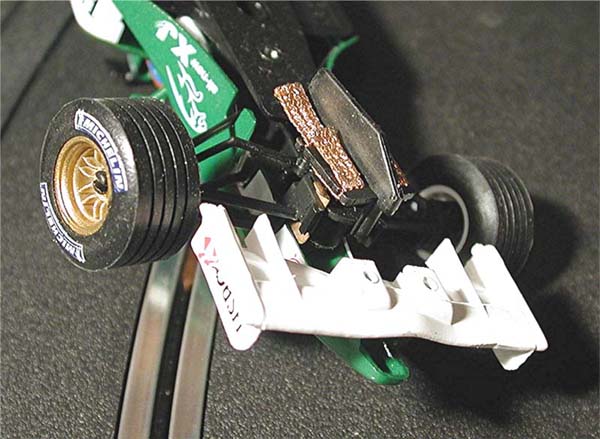
I can’t find dimensions for the 1:1 Jaguar F-1, but the SCX car is close to other recent offerings by SCX, Ninco and Scalextric. Wheelbase for the SCX car is 100mm, a rear track of 67mm and a front track of 64mm. My Ninco Arrows F-1 has a wheelbase of 93mm, a rear track of 65mm and a front track of 65mm. My Scalextric Renault F-1 has a wheelbase of 98mm and a front and rear track of 58mm. It is my understanding that the narrower track on the Scalextric car is much closer to being an accurate representation of modern F-1 cars. Regulations limit the maximum width of the 1:1 cars to 180cm, which translates into a 1/32 scale width of 56.25mm. As you can see by the dimensions listed above, the track on the SCX and Ninco cars is substantially wider than it should be. Some of this revolves around the need to more room around the front suspension for the steering front wheels. NOTE: Those who would prefer a narrower track on the SCX car or would like to replace the steering front wheels with a solid front axle should check the July/August 2002 issue of Model Car Racing magazine, which explains how to reduce the “wide track” stance of the SCX car to more accurately simulate a modern F-1.
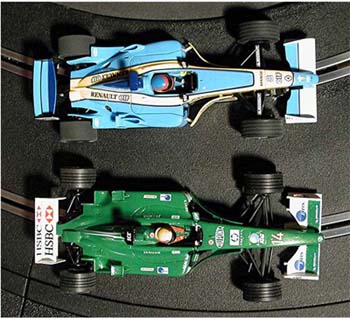
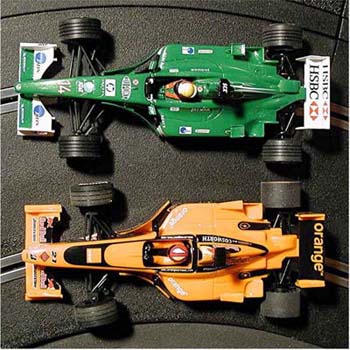
The wheels are shod with SCX’s standard hard rubber tires, grooved to simulate modern F-1 tires. Michelin markings grace the tire sidewalls. The tires are not nearly as soft as the ones on recent Scalextric F-1 cars. In addition, the wheel/tire size that SCX uses is fairly uncommon, at least here in the US, making it a challenge to fit stickier after-market tires. Still given the motor and the magnet that this car comes with, they work relatively well. The wheels and axles ran relatively straight and round on my car, but a light scuffing with some sandpaper to true the tires seems to improve grip slightly.
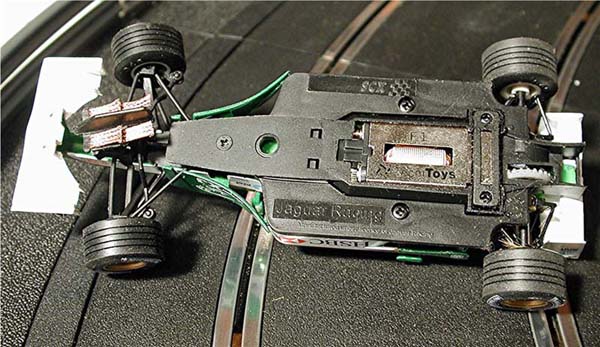
The magnet is another familiar and unique SCX feature. Located just ahead of the rear axle, the magnet is held in place by two long screws and can be adjusted up or down to alter the amount of grip that the car gets. All the way down turns the car into a “rubber band” runner - just wrap a rubber band around your controller to hold it on full throttle and watch the car blast around the track. Adjust the magnet for minimal grip and the Jag will fishtail around most of the corners on my Scalextric SPORT layout, slowing down the lap times substantially. Still, even with minimal grip, the car is very stable around the track and requires relatively ham-fisted driving to send it out of the slot. For beginners and young drivers, the SCX may well be more fun to drive because they spend more of their time driving and less of their time putting the car back on the track.
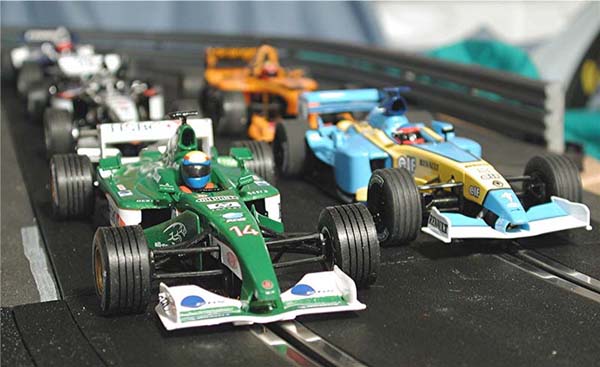
On my 50’ Scalextric SPORT track the Jaguar turned laps in the 6 second range with the magnet in minimal down force mode, and lap times just under 5 seconds with the magnet in its maximum down force position. By comparison, a Scalextric SPORT Renault F-1 will turn lap times in the 4.5 second range while a Ninco F-1 runs times in the mid-5 second range. This puts the SCX car mid-pack for modern Formula ones – about where the 1:1 car is right now – but well within the range of being competitive. Look for an upcoming article on how to bring the performance of these different F-1 cars even closer together.
The Jaguar, and most other SCX Formula One cars I have driven, has a different “personality” than Scalextric or Ninco F-1 cars. They tend to have less acceleration than the other brands, but make up for that deficit with added cornering grip, thanks to the low magnet location. Good lap times with an SCX car are all about preserving momentum and using cornering grip to its best advantage. Remember, the faster you corner the faster you are going at the beginning of a straight, and you carry that extra initial speed all the way around the track. It takes a while to get used to, but once you get the hang of it you’ll be dicing with those other brands of F-1 cars, slipping ahead on the corners and dropping back a bit on the straights.
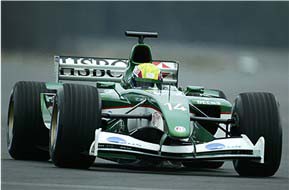
All in all, I’m very pleased with my Jaguar F-1. (How can you go wrong with a green Jaguar!) SCX shows signs of steady improvement with their product, though locating the cars in the US can still prove difficult at times. The Jag is a stunning looker, a nice runner and a pleasant addition to the field of modern F-1 racers.
As always, feel free to drop me a line with any comments or questions (nilshf@earthlink.net) or look for “nilsnews” on the HRW discussion board.
Happy Racing!
-Nils